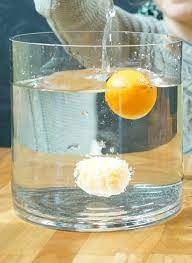
What you need:
Two oranges, A deep bowl and Water.
What to do:
- Fill the bowl with water.
- Keep one orange as it is and peel the other.
- Put both oranges in the bowl.
What happens?
The peeled orange sinks while the unpeeled one floats! That’s surprising isn’t it, considering that the one without the peel should be heavier?
Why?
The answer lies in density. We all know that everything on Earth is made up of small particles called atoms which give mass. The closer the atoms are packed together, the denser an object is said to be. For example, if you have a ball of cotton and a ball of iron, which one will be denser? The iron, because cotton has more air pockets between its particles. So the cotton atoms are not squeezed together in a small space like the iron atoms.
Now that we know density, we can understand floating. Simply, put in order to float in a liquid, an object needs to have lesser density than that liquid. The peel of an orange is special. It has a lot of air pockets in it. These air pockets give the orange less density than water. So it floats.
Once the peel is removed, there are no air pockets anymore on the orange’s body. It’s just straight, solid flesh. So it’s more dense than water and it sinks.
Picture Credit : Google




